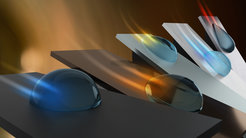Inclined drops
Model allows description of slipping drops
The behavior of drops on surfaces is of interest for a variety of applications. However, properties such as velocity, friction or shape on inclined surfaces depend on a large number of parameters - their behavior is still not completely predictable by theories. Researchers led by Hans-Jürgen Butt of the Max Planck Institute for Polymer Research have now tackled this problem and developed a simple phenomenologicalmodel that allows them to accurately predict the path of a drop.

Whether it's an inkjet printer, a solar cell, eyeglasses or a camera, the interaction of drops with surfaces plays a role in a variety of everyday phenomena. In the case of an inkjet printer, drops must remain in place for a long time in order to produce an exact print dot. In the case of solar cells, however, drops should run off as quickly as possible, taking dirt with them - the same is true for eyeglasses or camera lenses, on which drops obstruct vision.
However, how drops interact with surfaces and how they behave on them is a complex process at the microscopic level that depends heavily on the properties of the surface. To date, it is impossible to predict the roll-off speed and thus friction of a drop on a surface. Water-repellent surfaces tend to provide spherical drops that show little friction with the surface. Thus they can roll off even at small angles of inclination. Water-loving surfaces lead to flat drops that require large tilt angles to move.
Given the large number of surfaces and liquids that can come into contact with each other in technological applications, Hans-Jürgen Butt, Rüdiger Berger and colleagues asked themselves how the interaction with the surface and thus also the friction of drops can be described as universally as possible. To this end, they measured various drop parameters on inert, i.e. non-chemically reacting, and smooth surfaces: What is the velocity of the flowing drop? What is the width or length of the drop? What angles does the liquid surface make with the solid surface - at the front and back ends of the drop?
By measuring the behavior of different liquids, such as water, glycerin or silicone oil, on different surfaces, such as silicon, glass or Teflon, the researchers were able to determine a correlation. This shows that the friction of a drop of liquid on a surface can be described solely by a dimensionless parameter. This, in combination with the properties of the liquid described by its viscosity, can fully describe the roll-off speed of drops. Xiaomei Li, a doctoral student who was heavily involved in the project, says: "As a chemist, I never thought I would be studying the friction of fluids. When I started the project, I could not imagine that rolling drops could be described quite easily with just one dimensionless parameter. Everything seemed much more complicated." Rüdiger Berger, group leader in Butt's department, adds: "Drops are fascinating. Every drop I encounter now, whether in the shower or while cooking, I see in a new light. How does the drop move? Why is it moving, and is it going to get stuck somewhere?"
The investigations were supplemented by numerical simulations carried out as part of the SFB 1194 collaborative research project. These show that friction in the liquid drop takes place to a large extent along the drop edge to the surface.
With their work, the scientists hope to be able to accurately predict the behavior of drops on surfaces in the future and thus predict which surface is best suited for which application. They have now published their results in the journal Nature Communications.












